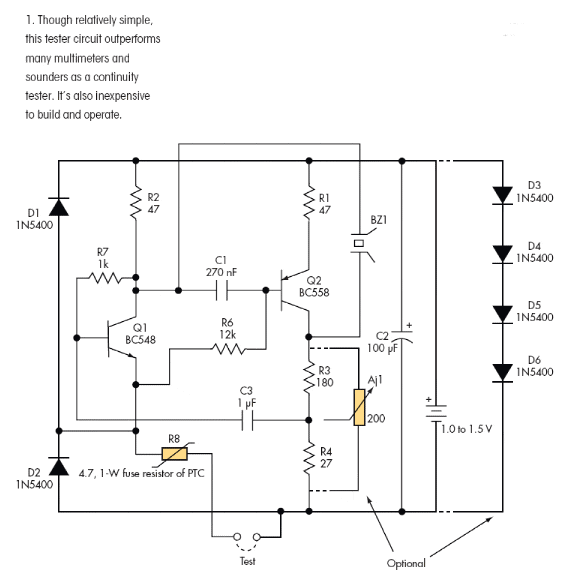 | ||||
HOME | ESR Meters | LCR Meters | Continuity-Low Ohm Meter |Geiger Counters | Tektronix | Metal Detectors | Contact Projects | Other Lab Tools | Solar | Master-Slave Switch | Semiconductor | ||||
 | ||||
WARNING: SOME COMMENTS ON THE ORIGINAL LINK SAYS THIS DOES NOT WORK... | ||||
“Ultimate” Continuity Tester Hides Many Tricks Up Its Sleeve Oct 2, 2008 Louis Vlemincq | Electronic Design COMMENTS 2 I WAS REMINDED RECENTLY of a tester I designed years ago. At the time, I wanted to build “The Ultimate Continuity Tester,” and I established a wish list of all the features I required: • A “real continuity” tester. Too many multimeters and sounders react at resistances as high as hundreds or even thousands of ohms, which makes them practically useless in many cases. Within a board or a system, there are always medium-conductivity paths everywhere, so they sound most of the time. A connector, a PCB track, or a wire, even a long one, has a resistance generally below 1 . Having a threshold much higher than that generates false alarms. • Speed. Many testers require a contact of tens of milliseconds or more, which makes the testing of large numbers of connections very frustrating. It is impossible to swipe quickly across a large number of pins. • Cheap to make and use. That meant a very small number of dirt-cheap components and a power consumption as frugal as possible from a cheap power source. This ruled out the usual 9-V battery, one of the least efficient and most expensive sources available. • No power switch. You invariably forget it’s “on” the afternoon preceding your holiday leave, and timers aren’t good enough. They tend to go off unnoticed just when you reach the wanted connection. • Ruggedness. You can sometimes inadvertently test charged capacitors or energized circuits, and the tester must survive such situations. • Safety. Even with the most sensitive electronics, safety means low voltage and current at the test probes. At first sight, the circuit in Figure 1 doesn’t seem very impressive, but it fulfills all of these requirements, and then some. It looks like some half-cooked multivibrator, but appearances can be deceptive. Q1 and Q2 form a two-stage, non-inverting amplifier, whose input and output are connected via C3 in order to cause oscillations. Each stage has its gain carefully defined: Q1 by the ratio of R4 to R1, and Q2 by the ratio of R2 to the sum of R8 and whatever sits between the test probes. When the product of these gains exceeds unity, oscillation occurs. With the values shown, the oscillation condition is met when the contact under test is less than 5 . Other values are possible by altering the R3/R4 ratio, or both resistors can be replaced by a trimpot, Aj1. To maximize the drive with the low supply voltage, the piezo-buzzer (BZ1) is connected between antiphase outputs of the oscillator. The resulting sound isn’t very loud with a standard transducer, but it’s quite sufficient for a lab or office environment. R8, together with D1 and D2, protect the tester in case it’s accidentally connected to a live circuit. It’s a 1-W, preferably fusible, resistor. For an extended and resettable protection, it can be substituted with a positive temperature coefficient resistor. If so, the resistor will be able to withstand a prolonged connection directly across the mains. Optional diodes D3 to D6 can be installed in parallel with the battery to ensure its protection. The battery can be a single standard or rechargeable AA cell, since the circuit operates from 1 to 1.5 V. A power switch is unnecessary because the test terminals also act as a switch. The only quiescent current is caused by leakages in the components—typically in the hundreds of nanoamperes range. When the terminals are shorted, the current rises to about 10 mA. So in normal operation, the battery will last for years, and it can be soldered in place. The buzzer can be any cheap, passive type. As noted, this circuit goes beyond the requirements of the “ultimate” continuity tester. For example, it not only checks the resistance, but also the modulus of the impedance presented to the test probes. In some cases, this can make a big (and useful) difference. The secondary of a 50/60-Hz transformer will generally have a dc resistance below the 5- threshold, but its impedance is mainly inductive and higher than 5 , so no oscillation will take place. There will simply be a light “click” at the instant the circuit is made, because BZ1 receives a pulse via R2 and R4. This will always be the case when a galvanic contact is made between the probes. This is a useful feature because you can differentiate between the wires of a multitap transformer, where a more conventional tester sees a bunch of shorted wires. Also, when a single diode in a bridge rectifier is shorted, you can immediately pinpoint the faulty one without any de-soldering. But there is more. If the transformer itself is faulty, with one or more turns shorted, the tester will sound. And if any of the windings are connected in opposition, it will also sound. This feature lets you determine the phase of the windings, both primary and secondary. Figure 2 shows a number of situations and their consequences for a typical dual-primary/dual-secondary transformer. Therefore, you can comprehensively test a transformer without ever connecting it to the mains. Finally, note that if you use a rechargeable battery, there’s no need for a specific charge connector. The test terminals can act as an input to the charger, via protection diode D2. | ||
 | ||
Electronic Design Ultimate Continuity Tester